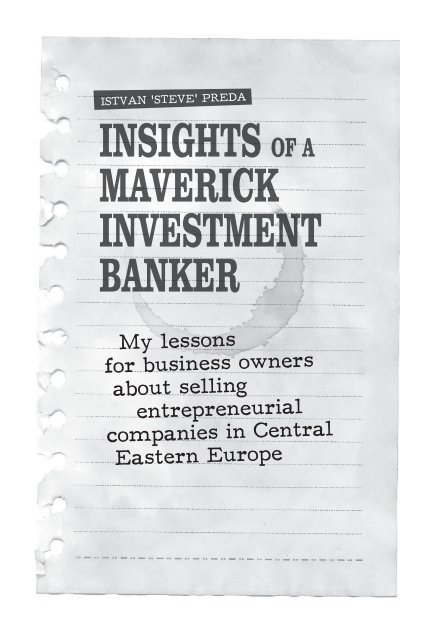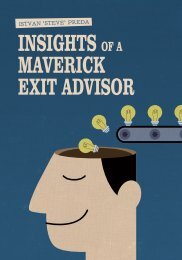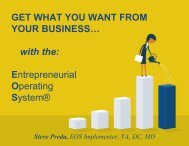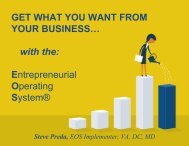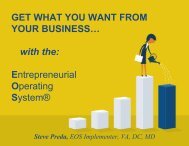Insights of a Maverick Investment Banker_Sample
Many successful entrepreneurs start with no or minimal capital. Some due to lack of financing, others to manage risk. Better to double up as experience grows, than go bankrupt before the business finds its path to success and scalability. Visit Us:- https://entrepcoaches.com/
Many successful entrepreneurs start with no or minimal capital. Some due to lack of financing, others to manage risk. Better to double up as experience grows, than go bankrupt before the business finds its path to success and scalability.
Visit Us:- https://entrepcoaches.com/
Create successful ePaper yourself
Turn your PDF publications into a flip-book with our unique Google optimized e-Paper software.
ISTVAN ‘STEVE’ PREDA<br />
INSIGHTS OF A<br />
MAVERICK<br />
INVESTMENT<br />
BANKER<br />
My lessons<br />
for business owners<br />
about selling<br />
entrepreneurial<br />
companies in Central<br />
Eastern Europe
© 2013 by Istvan ‘Steve’ Preda. All rights reserved. No part <strong>of</strong> this publication may<br />
be reproduced, stored in a retrieval system, or transmitted in any form or by any<br />
means electronic, mechanical, photocopying, recording, or otherwise, without the<br />
written permission <strong>of</strong> the author or publisher.<br />
Library <strong>of</strong> Congress Control Number: 2016920070<br />
Published by: Amershire Publishing<br />
Websites: www.entrepcoaches.com, www.imapmb.com<br />
Illustration: Ákos Kiss, Rajzákos<br />
Book Design: Zoltán Ember, a4-design<br />
Text Editor: Erzsébet Aponyi<br />
Publisher’s Cataloging-in-Publication data<br />
Names: Preda, Steve, author.<br />
Title: <strong>Insights</strong> <strong>of</strong> a maverick investment banker / Steve Preda.<br />
Series: <strong>Insights</strong> <strong>of</strong> a maverick.<br />
Description: Includes index. | Second edition. | Glen Allen, VA: Steve Preda Entrep<br />
Coaching, 2017.<br />
Identifiers: ISBN 978-0-9984478-2-7 (pbk.) | 978-0-9984478-3-4 (ebook)<br />
Subjects: LCSH <strong>Investment</strong> banking. | <strong>Investment</strong>s. | <strong>Investment</strong> analysis. | Risk<br />
management. | Small business--Finance. | Sale <strong>of</strong> business enterprises. |<br />
Entrepreneurship. | Success in Business. | BISAC BUSINESS & ECONOMICS /<br />
<strong>Investment</strong>s & Securities / General<br />
Classification: LCC HG4529 .P743 2017 | DDC 332.6--dc23
Contents<br />
Preface<br />
Buyer Hunting<br />
Seven Pitfalls to Avoid When Building for Sale<br />
Company Selling Myths<br />
Teaching From the Trenches<br />
Rip Your Company-Muscles<br />
GDP Kerosene<br />
Synergies From Entrepreneurial Investors<br />
Swell, Sell Or Slaughter<br />
Start It, Build It, Sell It<br />
5<br />
7<br />
17<br />
25<br />
31<br />
37<br />
41<br />
47<br />
51<br />
55
Preface<br />
This book represents a collection <strong>of</strong> articles I wrote for the<br />
Firm Value newsletter between 2007 and 2012, some <strong>of</strong> which<br />
have never been published in English before. My goal was to<br />
share with you my experiences in raising capital and selling<br />
companies in the challenging investment markets <strong>of</strong> Central<br />
Eastern Europe. I hope you will find my writings interesting and<br />
instructive.<br />
Building a pr<strong>of</strong>itable business, positioning it as a marketable<br />
product, financing its growth and eventually monetizing it is<br />
always challenging and usually a long and arduous process. Most<br />
<strong>of</strong>ten, small to medium sized businesses are sold when the<br />
founders have reached a plateau from which they have no<br />
appetite to make another run, for lifestyle or risk management<br />
reasons.<br />
Why take on the burden <strong>of</strong> recruiting a management team or<br />
scale to the next level when you can walk away with a multiple <strong>of</strong><br />
pr<strong>of</strong>its and enjoy other activities, perhaps including launching<br />
another business? For entrepreneurs, creating something new is<br />
more exciting than tweaking and optimising an existing<br />
business. Let strategic or private equity investors define a new<br />
vision, hire pr<strong>of</strong>essional managers, pile cash into new<br />
equipment and ascend the next mountain.<br />
Wishing you a good read and rising equity value.<br />
Istvan ‘Steve’ Preda<br />
Glen Allen, Virginia, August 2013<br />
5
6
BUYER<br />
HUNT<br />
ING
INSIGHTS OF A MAVERICK INVESTMENT BANKER<br />
Buyer Hunting<br />
“Investors... Where to Find Them?”<br />
This has been the most common question I received over the<br />
years from prospective clients. An obvious inquiry, but one hard<br />
to give a brief answer to. Therefore, here is the long answer I<br />
would give if there was ever time to explain this topic in person.<br />
Understand the Business<br />
8<br />
Stalking investors is a complex and multi-stage process. The<br />
first step is to understand the business: Who will benefit from<br />
buying the company? The more specialized its activity, the fewer<br />
will be the potential investors.<br />
How sustainable is the underlying business? To answer this,<br />
study the company, its markets and competitors. What drives<br />
growth? Where is the market going? How will investors make<br />
money tomorrow? Do you need new ideas or a new management<br />
team to make the target more attractive?<br />
Let’s take the example <strong>of</strong> a leasing s<strong>of</strong>tware developer. This<br />
company could be interesting for the following buyer types:<br />
• Diversified s<strong>of</strong>tware companies aiming to break into the<br />
leasing s<strong>of</strong>tware market;<br />
• Hardware distributors seeking to sell products to financial<br />
institutions;<br />
• Debt collection agencies supporting the leasing customers <strong>of</strong><br />
the s<strong>of</strong>tware developer;<br />
• Banking-s<strong>of</strong>tware companies looking to plug holes in their<br />
product portfolios;
BUYER HUNTING<br />
• Family <strong>of</strong>fices seeking growth-investment opportunities;<br />
• Private equity funds looking for platform investments to<br />
expand organically, or through acquisitions.<br />
• Conglomerates seeking a flying start in s<strong>of</strong>tware<br />
development, by buying an existing operation;<br />
• Dealerships wanting to beat their competition by acquiring a<br />
proprietary leasing product;<br />
• International leasing s<strong>of</strong>tware developers that want to<br />
recruit the management team <strong>of</strong> the target, etc.<br />
To understand the business, study the company, its markets,<br />
its competitors, and its peers. Research market trends,<br />
companies <strong>of</strong>fering substitute products and services, the life<br />
cycles <strong>of</strong> similar products, the behaviors <strong>of</strong> competitors,<br />
acquisition strategies and the bottlenecks and maturity <strong>of</strong> the<br />
company’s markets.<br />
Size up the growth potential <strong>of</strong> the market and the company<br />
and, if these are modest, find alternative strategies for buyers to<br />
generate further growth. If the buyer will not see how to make<br />
the company more valuable, it will <strong>of</strong>fer a lot less for it.<br />
“Investors...<br />
where to find them?”<br />
Was the most common question<br />
I received over the years<br />
from prospective clients.<br />
9
INSIGHTS OF A MAVERICK INVESTMENT BANKER<br />
If necessary, model growth opportunities in the form <strong>of</strong> a<br />
business plan, demonstrating the capital expediture and<br />
financing needs and risks <strong>of</strong> growing the company. If the<br />
founders want to exit at once, consider recruiting new<br />
management, that would help create and underwrite a growthvision<br />
for the company.<br />
Brainstorming<br />
Linus Pauling, Nobel Prize winning American chemist,<br />
proclaimed that: “In order to have good ideas, we must have<br />
many ideas”. The secret <strong>of</strong> idea generation is to harness your<br />
own and your team’s creativity.<br />
Brainstorm to find non-obvious buyers. Brainstorm alone,<br />
brainstorm with colleagues, with clients, with investment<br />
bankers, with their archives <strong>of</strong> past deals and with industryinsiders<br />
and personal contacts. Record your ideas using mind<br />
maps, blobs and sticks.<br />
Buyer Types<br />
10<br />
Historically all our clients wanted strategic buyers (also<br />
called: “trade buyers”), as it is logical to assume that trade buyers<br />
with potential synergies and strategic growth interests should<br />
be willing to pay the highest prices for acquisitions.<br />
Strategic buyers are <strong>of</strong>ten interested in capturing markets,<br />
seeking synergies, pursue vertical integration or diversification.<br />
In the case <strong>of</strong> a meat processor, the acquisition <strong>of</strong> breeding<br />
farms, feed-mixing plants, slaughterhouses and retail<br />
distribution chains will increase net margins and help reduce<br />
the volatility <strong>of</strong> pr<strong>of</strong>its, both <strong>of</strong> which could add value to an<br />
acquiror.<br />
Producers <strong>of</strong> substitute products or services may also be good<br />
strategic buyers. A fish-processing company could be an<br />
interesting target for a meat processor seeking to diversify into<br />
healthier alternatives. Similarly, a budget airline might buy a
BUYER HUNTING<br />
coach operator to hedge itself against the risk <strong>of</strong> terrorist attacks,<br />
which may divert air travelers to roads. Such tie-ups could also<br />
allow the cross-selling <strong>of</strong> services to both buyer and target.<br />
Clients <strong>of</strong>ten treat financial buyers with skepticism, but these<br />
days private equity funds and family <strong>of</strong>fices manage more money<br />
in America than the combined capitalization <strong>of</strong> public<br />
companies, so they should not be ignored.<br />
Financial investors <strong>of</strong>ten show more interest and bid higher<br />
than strategics. Funds are under pressure to invest and they will<br />
buy anything that can be fixed, grown, leveraged or consolidated<br />
and has solid cash flows.<br />
Even when they do not outbid trade buyers, their presence<br />
will allow the seller to increase bidding pressure and achieve a<br />
higher sale price than with marketing to strategics alone.<br />
While strategic buyers are <strong>of</strong>ten focused on buying market<br />
share and have narrow prospectives regarding the growth<br />
potential <strong>of</strong> a target, financial investors tend to be open to ideas<br />
on how to grow the business. Advisors add value by helping to<br />
draw up an ambitious vision for the buyer and enlist outside-, or<br />
prop up inside-management teams to sell it as their own.<br />
Private equity funds will also consider companies with<br />
limited organic growth potential, provided they can be used as a<br />
platform for a roll-up <strong>of</strong> similar companies, have a business<br />
model that can be exported, and solid leverageable cash flows.<br />
Investor Universe<br />
The next step is to use the investment pr<strong>of</strong>iles created to<br />
uncover matching potential investors. The source <strong>of</strong> such buyers<br />
may include, but would not be limited to, the following options:<br />
<strong>Banker</strong> contacts, past acquirers, databases <strong>of</strong> US, European<br />
and Asian strategic investors and specialist private equity funds,<br />
listed companies, players found in industry research and news<br />
archives.<br />
There are also subscription-based “dating platforms” for<br />
company sellers and buyers, such as Axial.net, which allow the<br />
sellers’ advisors to selectively and gradually reveal information to<br />
11
INSIGHTS OF A MAVERICK INVESTMENT BANKER<br />
qualified and vetted parties looking for opportunities in certain<br />
sectors and situations.<br />
The thus researched buyers all go into a “long list”, which is<br />
then filtered to weed out the low-potentials. What remains is<br />
investors for whom the target makes strategic sense, that have<br />
cash or a strong balance sheet to finance the purchase, and are in<br />
a growth phase.<br />
From this reduced list: (1) serial acquirers, (2) growthcompelled<br />
public or private equity owned companies, and (3)<br />
highly synergistic buyers are prioritized. To these, add hot<br />
contacts <strong>of</strong> your investment banker and their network, where<br />
they are close to the ear or enjoy the confidence <strong>of</strong> a decision<br />
maker.<br />
One such hot contact-generated deal was my firm’s sale in<br />
2010 <strong>of</strong> green energy contractor STS Group to industrial holding<br />
Videoton, for whom this was the first foray into the energy<br />
sector. Personal contacts are <strong>of</strong>ten critical in selling companies.<br />
Stalking the Buyer<br />
12<br />
Cash rich and growth oriented companies are “eligible<br />
bachelors” that are constantly bombarded with acquisition<br />
ideas. However, most <strong>of</strong> these calls represent scattergun<br />
approaches, which CEOs will spend little time to consider.<br />
Companies with mergers and acqusitions (M&A) departments<br />
might review such cold mail opportunities, but even they must<br />
prioritize <strong>of</strong>fers from known sources that are perceived more<br />
credible.<br />
The opposite is the case when a decision maker receives a<br />
personal call from an intermediary or advisory company she is<br />
familiar with, and when there is a “face” to the opportunity.<br />
Successful investment bankers nurture their contacts by<br />
presenting to them only high-quality, tailor-made deals.<br />
Even inside our own international M&A organization,<br />
“IMAP”, those partners receive the most attention that deliver<br />
quality deals, versus the ”assembly-line producers”, that<br />
distribute proposals indiscriminately. It is important to only take
BUYER HUNTING<br />
on doable transactions and present them in a digestible and userfriendly<br />
format, as the attention span <strong>of</strong> buyers and their<br />
advisors is short and they are looking to disqualify anything that<br />
is outside the sweet spot <strong>of</strong> their interest.<br />
Evaluation<br />
Shortlisted buyers sign non-disclosure agreements, receive<br />
investment memos and a timetable with next steps. Some misshits<br />
give insights into neglected areas and unearth new<br />
brainstormable fields <strong>of</strong> research and <strong>of</strong>ten lead to finding new,<br />
unobvious buyers, with high added value.<br />
After strategic buyer sources have been exhausted, move on<br />
to financial investors. Here the industry specialist and<br />
geographically focused buyers are prioritized over generic<br />
private equity funds.<br />
Alternative Strategies<br />
If the basic strategies prove unsuccessful, turn to other ways<br />
to fulfill your objectives.<br />
Outliers. One such approach is to find outlier buyers out <strong>of</strong><br />
sight <strong>of</strong> your network’s contacts, <strong>of</strong>ten in international markets<br />
through one <strong>of</strong> the earlier mentioned “dating platforms”.<br />
Years ago, such a service helped us locate an Indian buyer for a<br />
South Hungary based industrial company. The buyer conducted<br />
a due diligence, but eventually pulled the plug due to<br />
communication problems with the management team that was<br />
positioned to take over from the founders. The fact that there was<br />
no restaurant in town that the vegan buyers liked did not help<br />
either. Lesson: Cultural differences can create critical obstacles to<br />
deals and must be managed continuously and carefully.<br />
MBO or MBI. Another option is to arrange a management<br />
buyout (“MBO”) or management buy in (“MBI”) to mobilize<br />
management from within, or from outside the company,<br />
respectively, and to raise financing for such purchasers to<br />
13
INSIGHTS OF A MAVERICK INVESTMENT BANKER<br />
acquire a majority or a large minority stake. (The better known<br />
MBO’s are actually rarer, as exits are more <strong>of</strong>ten catalyzed by the<br />
lack <strong>of</strong> inside succession management and the burnout <strong>of</strong> the<br />
founder.)<br />
Equity release or Recap. Often called: Dividend<br />
Recapitalization or “Recap”, an equity release allows the<br />
founders to take money out <strong>of</strong> the business in exchange for a<br />
large minority or small majority equity stake, financed by a<br />
combination <strong>of</strong> equity investments, bank debt, or mezzanine<br />
equity. Recaps are <strong>of</strong>ten followed by a subsequent transaction<br />
after three to five years when the investor would exit, giving the<br />
founder a “second bite <strong>of</strong> the apple”.<br />
Gradual Sale. These are last-ditch solutions for companies<br />
which are <strong>of</strong>ten not, or only marginally pr<strong>of</strong>itable, have no<br />
management to take them over, or promise low growth. In such<br />
situations, the main value is the market presence <strong>of</strong> the company<br />
and its <strong>of</strong>fering. In order to create material equity value which<br />
can eventually be sold, an appropriately connected and<br />
competent management team is needed.<br />
In return for their efforts, and occasionally monetary equity,<br />
the incoming managers will get to ride a “horse”, i.e. will have the<br />
opportunity to take over the leadership <strong>of</strong> a mature company,<br />
which is <strong>of</strong>ten easier then to start a new one up.<br />
A gradual sale will only work if the parties trust each other.<br />
The seller will have to allow the investor to assume the reigns,<br />
and the buyer will have to rely on the seller’s assurances that he<br />
would not abuse his majority rights to deny the buyer’s share <strong>of</strong><br />
the eventual pr<strong>of</strong>its, and to later allow the transfor <strong>of</strong> control at a<br />
pre-agreed price.<br />
Gradual sale works best in the case <strong>of</strong> intra-family, intracompany<br />
successions, or with reliable business partners.<br />
Winding Up. The final alternative to a sale is a winding up,<br />
where the sellers harvest the value <strong>of</strong> their company by selling<br />
assets and liberating working capital.<br />
14
BUYER HUNTING<br />
This strategy will work for companies where there is no buyer<br />
who would pay for goodwill, or even the book value <strong>of</strong> the firm,<br />
while there are significant and monetizable working capital<br />
assets (sellable inventories, collectable receivables) tied up in the<br />
company.<br />
Such companies <strong>of</strong>ten operate without recognizable brands,<br />
at low margins, sometimes at the mercy <strong>of</strong> big box retail<br />
customers that pay them slow and require them to warehouse<br />
and take back unsold products. Importer-distributors <strong>of</strong> Far<br />
Eastern commodity consumer products <strong>of</strong>ten end up with this<br />
fate.<br />
15
16
SEVEN<br />
PITFALLS<br />
TO AVOID<br />
WHEN<br />
BUILDING<br />
FOR SALE
INSIGHTS OF A MAVERICK INVESTMENT BANKER<br />
Seven Pitfalls<br />
to Avoid When<br />
Building for Sale<br />
If you are building your company for exit, it’s worth avoiding<br />
the most common obstacles in the way <strong>of</strong> building and eventually<br />
selling your business. Here are the seven biggest:<br />
People vs. Procedure<br />
18<br />
Good people are key. A sellable business is built on people,<br />
who can eventually run it without the founder. It is hard to hire<br />
the best people when starting out, as the ablest graduates<br />
gravitate to high-paying, well-established companies. Even for<br />
high-growth startups it may take years to become able to attract<br />
top graduates.<br />
Experienced people are also difficult to hire, as they are either<br />
already successful where they are, and thus will stay put, or not so<br />
much, while still expecting high salaries and benefits. If Fortune<br />
500-groomed, they may also be the wrong fit for an<br />
entrepreneurial culture.<br />
Don't be at their mercy. If you eventually get to hire the best<br />
and the brightest, be sure they do not become indispensable and<br />
get to “own” part <strong>of</strong> the enterprise value <strong>of</strong> your company. Small<br />
business niche marketing guru, Dan Kennedy, famously stated<br />
that “” is the worst number in business. Don’t allow any<br />
individual to monopolize sales relationships or processknowledge<br />
in your business.<br />
Big companies train associates for the jobs <strong>of</strong> neighboring<br />
departments to cover for vacations and career changes, and to<br />
build the business on documented processes. Failing this, your<br />
enterprise is under the risk <strong>of</strong> its intellectual capital walking out
SEVEN PITFALLS TO AVOID WHEN BUILDING FOR SALE<br />
the door, or dictating a pay rise. Build job descriptions and<br />
procedures as soon as they crystallize. Even write a procedure for<br />
writing procedures.<br />
Hold the keys. The owner should, as long as possible, control<br />
key functions: strategy, innovation, marketing, financing. Brands<br />
and intellectual property need to be protected and ring-fenced<br />
from the business, so a frivolous lawsuit cannot deprive you <strong>of</strong><br />
key components <strong>of</strong> your enterprise. This is easiest done through<br />
an asset holding company, incorporated in a high-security, lowreporting<br />
jurisdiction, such as Nevada. Your tax advisor will<br />
know.<br />
“Hold the keys”<br />
The owner should,<br />
as long as possible,<br />
control key functions:<br />
strategy, innovation,<br />
marketing, financing.<br />
One Person Show<br />
All companies start that way and many remains stuck at the<br />
level <strong>of</strong> being a founder-dominated organization. It is a natural<br />
start, as typically the founder represents the brains, heart and<br />
work ethics <strong>of</strong> the organization, until his values become wired<br />
into the culture <strong>of</strong> the company.<br />
The founder is <strong>of</strong>ten a driven man or woman, who will<br />
accomplish the task <strong>of</strong> five to ten employees. The owner’s cheap<br />
labor makes the early company pr<strong>of</strong>itable and self sustaining, and<br />
the start-up will not have the scale for a while and be able to<br />
afford to pay the staff that would have to replace them.<br />
19
INSIGHTS OF A MAVERICK INVESTMENT BANKER<br />
Over time, most companies reach the stage where the<br />
founders cannot anymore efficiently keep all critical functions in<br />
hand. At this point, they should document their functions and<br />
spin <strong>of</strong>f jobs for which affordably paid employees can be trained.<br />
This move will feel costly and inefficient initially, but it is the<br />
only way to free up the founders, so that they can focus on more<br />
valuable growth opportunities. A one-man consulting firm with<br />
limited overhead will almost always make a higher margin on<br />
labor, but it is a pr<strong>of</strong>essional practice not a business.<br />
The Bootstrap Trap<br />
Many successful entrepreneurs start with no or minimal<br />
capital. Some due to lack <strong>of</strong> financing, others to manage risk.<br />
Better to double up as experience grows, than go bankrupt before<br />
the business finds its path to success and scalability.<br />
The flip side <strong>of</strong> risk-management is slow growth, and while<br />
the founder avoids debt and dilution, competitors may develop<br />
faster and overtake the leader in the market. In many industries<br />
the leader makes most <strong>of</strong> the pr<strong>of</strong>it, so it’s not fun being an alsorun.<br />
There is an inflection point at which the founders may<br />
consider bringing on board an investor to fund the acceleration<br />
and the rollout <strong>of</strong> their, by then proven, business model.<br />
The other danger <strong>of</strong> bootstrapping is that it can kill the<br />
momentum <strong>of</strong> the company. When sales or pr<strong>of</strong>itability start to<br />
flatten, investor interest falls <strong>of</strong>f dramatically. The<br />
entrepreneur’s confidence could also falter, causing burnout<br />
instead <strong>of</strong> the exhilaration that is critical to their success.<br />
The key to partnering is keeping control <strong>of</strong> the business<br />
trough continual initiatives and by balancing risk and<br />
performance.<br />
20
SEVEN PITFALLS TO AVOID WHEN BUILDING FOR SALE<br />
Top Line Focus<br />
The fast growth <strong>of</strong> the early years will not last forever. At some<br />
point the business will exhaust its pr<strong>of</strong>itable niche and will be<br />
forced to enter markets on the fringe <strong>of</strong> its core competence,<br />
where growth will come at the expense <strong>of</strong> eroding margins.<br />
The founder is <strong>of</strong>ten the engine <strong>of</strong> value creation, so it is<br />
unavoidable that pr<strong>of</strong>it margins fall as his impact is becoming<br />
spread thinner in a growing company, over time. Scaling helps<br />
reduce proportionate expenses, but corporatization <strong>of</strong>ten<br />
alienates people and attracts slackers. It takes the focus and<br />
ruthless discipline <strong>of</strong> Jack Welch to constantly weed out subpar<br />
performers.<br />
The top line is <strong>of</strong>ten easy to grow at the expense <strong>of</strong><br />
pr<strong>of</strong>itability by taking on marginal projects. Your company must<br />
avoid commodity terrain by shifting attention to R&D,<br />
innovation and marketing. It will have to say no to marginal<br />
customers and opportunities, and constantly fine-tune, even<br />
shift, its <strong>of</strong>fering to stay in a differentiated and valuable market<br />
position.<br />
Buyer Becoming Boss<br />
The difference between a business and an outsourced provider<br />
is independence. It means serving multiple masters, none <strong>of</strong><br />
which can blackmail you into giving up your pr<strong>of</strong>its or strategy.<br />
Interdependence sounds nice, but rarely works in practice, as<br />
customers will loath to expose themselves to the performance<br />
risk <strong>of</strong> a single contractor and therefore will seek to keep multiple<br />
providers in play.<br />
Independence costs focus and performance and pr<strong>of</strong>its in the<br />
short term. However, when sales are concentrated with one or a<br />
handful <strong>of</strong> customers, the business faces the risks <strong>of</strong> exposure to<br />
the loss <strong>of</strong> key clients, weak position in price negotiations, and<br />
when a buyer dictates terms, the inability to develop proprietary<br />
products.<br />
21
INSIGHTS OF A MAVERICK INVESTMENT BANKER<br />
When dependence becomes permanent, it limits the value <strong>of</strong><br />
your business. The dependor will either deprive you <strong>of</strong> your<br />
pr<strong>of</strong>its, or become a de facto option-holder on your business.<br />
Worse, the dependor may become capable <strong>of</strong> taking over your<br />
business virtually for free by withdrawing orders, or blocking<br />
access to end-customers. Such step would threaten bankruptcy,<br />
unless you capitulate and give up control.<br />
Endeavor to reduce your concentration to any <strong>of</strong> your<br />
customers to below twenty percent <strong>of</strong> sales and make sure eighty<br />
percent <strong>of</strong> your sales and pr<strong>of</strong>its come from at least five<br />
customers.<br />
Playing Without Endgame<br />
22<br />
All good things come to an end, but for the end to be good, it<br />
must be planned.<br />
Companies grow to the size their founder can manage. Often<br />
this is the point where an independent management team will<br />
have to be appointed to facilitate further growth. However, this is<br />
a painful and risky step for many owners. A wrong choice can<br />
break momentum and extra costs will cut into margins and eat<br />
into equity value.<br />
Just the thought <strong>of</strong> letting go makes many entrepreneurs<br />
shiver. Transitioning the founder’s job will <strong>of</strong>ten take several C-<br />
level executives, who will want cars, secretaries and corner<br />
<strong>of</strong>fices, costing a bundle. The corporate incomers will try to<br />
“institutionalize” the company, which may dampen the<br />
motivation <strong>of</strong> legacy employees.<br />
Apart from transition issues, every founder or management<br />
team has a life cycle. Gene Landrum in Entrepreneurial Genius<br />
talks about a 15-20 year incubation period for billionaire<br />
entrepreneurs before they hit their stride. But billionaires are<br />
<strong>of</strong>ten the exceptions, who can rejuvenate when they have reached<br />
their original goals, while most entrepeneurs cannot.<br />
The average successful entrepreneur has a business life cycle <strong>of</strong><br />
10-15 years, over which they will accomplish their mission and<br />
gradually lose interest, or tire <strong>of</strong> growing the business. This
SEVEN PITFALLS TO AVOID WHEN BUILDING FOR SALE<br />
inflection point is where the most valuable exits <strong>of</strong>ten happen,<br />
when buyers are willing to pay for a still growing company.<br />
Catching the peak requires careful planning. Sadly, few<br />
entrepreneurs are aware <strong>of</strong>, and strategic enough, to plan ahead<br />
for the exit and thus most will fail to sell at the peak.<br />
The best sweetener to a sale is an in-house successor groomed<br />
for the job, who will underwrite the business plan for the investor.<br />
The founder may then depart with a full payout, in most cases.<br />
Selling Over the Hill<br />
Investors purchase companies to make a return. However, they<br />
will only succeed if they buy at a discount, or at the market price<br />
with the opportunity to grow the acquired business. Companies<br />
with low or no growth will sell at a discount or not at all.<br />
On the other hand, exiting too early leaves money on the table,<br />
when the company could have been sold at a multiple <strong>of</strong> higher<br />
pr<strong>of</strong>its.<br />
The trick is to start the sale process approximately twelve<br />
months before the anticipated peak. This will allow the company<br />
to continue growing through the auction process, maintaining<br />
the seller’s negotiating position to closing. Buyers love to buy into<br />
a growing business, and will be ready to pay for the future as well<br />
as the past. At least twelve months lead time is required as the<br />
process might drag out.<br />
If the numbers start flattening during the sale process, the<br />
buyer will get cold feet and disappear or begin chipping away at<br />
the price. It’s better to leave some meat on the bone than to restart<br />
a failed sale process for a company with stagnant or eroding<br />
earnings.<br />
23


